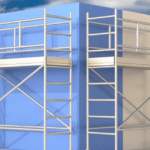In commercial and craft beer brewing, understanding the distinction between a boil kettle and a whirlpool vessel is crucial for producing high-quality beer. While these two pieces of equipment may appear similar at first glance, they serve fundamentally different purposes in the brewing process. This comprehensive guide will explore their unique functions, designs, and impacts on the final beer product.Micet Craft Brewing Equipment Manufacturers
1. Introduction to Brewing Vessels
Before diving into the differences, it’s important to understand where these vessels fit in the brewing process:
- Mash Tun: Where grains are mixed with hot water to convert starches to sugars
- Lauter Tun: Where the sweet wort is separated from grain solids
- Boil Kettle: Where the wort is boiled with hops
- Whirlpool Vessel: Where solids are separated from the boiled wort
- Fermenter: Where yeast converts sugars to alcohol
The boil kettle and whirlpool vessel handle critical post-mash processes that significantly influence beer clarity, flavor, and stability.
2. The Boil Kettle: Function and Characteristics
Primary Functions
The boil kettle serves several essential purposes in beer production:
- Sterilization: The boiling process (typically 60-90 minutes) kills any remaining microorganisms
- Hop Utilization: Allows for proper isomerization of alpha acids from hops
- Protein Coagulation: Causes proteins to clump together (forming “hot break”)
- Wort Concentration: Evaporates excess water (typically 5-15% volume reduction)
- Flavor Development: Creates Maillard reactions and caramelization
- DMS Removal: Volatilizes dimethyl sulfide (DMS) which can cause off-flavors
Key Design Features
Modern boil kettles incorporate several important design elements:
- Heating Methods:
- Direct-fire (gas)
- Steam-jacketed
- Electric elements
- Construction Materials:
- Stainless steel (most common)
- Copper (traditional, but less common today)
- Capacity:
- Typically 10-20% larger than mash tun to accommodate boil expansion
- Geometry:
- Wider than tall to maximize evaporation surface
- Dome tops help control evaporation rates
Temperature Considerations
Boiling occurs at:
- Sea level: 100°C (212°F)
- Higher elevations: Lower boiling points require longer boil times
3. The Whirlpool Vessel: Function and Characteristics
Primary Functions
The whirlpool vessel serves distinct purposes after boiling:
- Solids Separation: Removes hop particles and protein trub
- Wort Clarification: Produces clearer wort for fermentation
- Temperature Reduction: Begins cooling process before fermentation
- Aroma Preservation: Helps retain volatile hop compounds
Key Design Features
Whirlpool vessels have unique design considerations:
- Shape:
- Cylindrical with flat or slightly conical bottom
- Height-to-diameter ratio typically 1:1 to 2:1
- Inlet Design:
- Tangential inlet creates swirling motion
- Flow rate of 2-3 m/s generates proper vortex
- Separation Mechanism:
- Centrifugal force drives solids to center
- Forms dense trub cone (15-30° angle)
- Construction:
- Stainless steel (same as boil kettle)
- Often insulated to maintain temperature
The Whirlpool Process
A standard whirlpool procedure involves:
- Transferring wort from boil kettle
- Creating whirlpool motion (15-30 minutes)
- Resting period (20-30 minutes)
- Drawing off clarified wort from side port
4. Key Differences Between the Two Vessels
Characteristic Boil Kettle Whirlpool Vessel Primary Function Wort boiling and sterilization Solids separation Temperature Maintained at boiling Cooling begins (90-95°C) Agitation Vigorous boiling Controlled swirling Time in Operation 60-120 minutes 45-60 minutes Heat Application Constant heat input No heat applied Geometry Wider than tall Taller than wide Solids Management Creates hot break Separates trub and hops Common Volume 100% of batch size 100-110% of batch size
5. Combined vs. Separate Systems
Combined Kettle/Whirlpool Units
Many craft breweries use combination vessels to save space and cost:
Advantages:
- Lower equipment costs
- Reduced footprint
- Fewer transfer points (less contamination risk)
Disadvantages:
- Longer batch times (can’t boil next batch while whirlpooling)
- Less efficient separation
- Limited to smaller batch sizes (typically <10 BBL)
Dedicated Whirlpool Vessels
Larger breweries almost always use separate systems:
Advantages:
- Better separation efficiency
- Continuous brewing possible
- Handles larger batch sizes
- More consistent results
Disadvantages:
- Higher capital cost
- Requires more space
- Additional cleaning and maintenance
6. Impact on Final Beer Quality
Boil Kettle Effects
- Underboiling:
- Residual DMS (cooked corn flavor)
- Poor hop utilization
- Insufficient protein coagulation
- Overboiling:
- Excessive caramelization
- Loss of volatile aromas
- Darker color
Whirlpool Effects
- Poor Separation:
- Yeast stress from excess trub
- Haze formation
- Astringent flavors from hop polyphenols
- Optimal Operation:
- Cleaner fermentation
- Better hop aroma retention
- Improved beer stability
7. Maintenance and Cleaning Considerations
Boil Kettle Maintenance
- Regular descaling (especially in hard water areas)
- Inspection of heating elements
- Checking for scorch marks (direct-fire systems)
- Gasket and seal replacement
Whirlpool Maintenance
- Checking tangential inlet for obstructions
- Verifying proper slope for trub cone formation
- Inspecting racking arm positioning
- Cleaning between batches to prevent buildup
Both vessels require thorough CIP (Clean-in-Place) procedures using:
- Alkaline cleaner (for organic deposits)
- Acid cleaner (for mineral deposits)
- Sanitizer before next use
8. Technological Advancements
Boil Kettle Innovations
- Automated hop dosing systems
- Energy recovery systems
- Variable boil intensity control
- Integrated calandria heaters
Whirlpool Innovations
- Centrifugal separators
- Hydrocyclone technology
- Automated trub removal
- Inline wort oxygenation
9. Choosing the Right System for Your Brewery
Factors to consider:
- Batch size (current and future)
- Available space
- Production schedule
- Beer styles (some benefit more from separation)
- Budget constraints
For most breweries >7 BBL, dedicated vessels are recommended.
Conclusion
While the boil kettle and whirlpool vessel may appear similar, they perform completely different but equally vital functions in beer production. The boil kettle transforms wort through controlled boiling, while the whirlpool vessel refines it through precise separation. Understanding these differences allows brewers to optimize their processes for better efficiency and superior beer quality.
Whether using a combined system or separate vessels, proper operation and maintenance of both pieces of equipment are essential for consistent, high-quality beer production.
FAQs
1. Can I use my boil kettle as a whirlpool vessel?
Yes, many small breweries use combination systems. However, separation won’t be as efficient as with a dedicated whirlpool, and it extends your batch time since you can’t start the next boil while whirlpooling.
2. How important is the whirlpool step for hazy IPAs?
While hazy IPAs intentionally retain some hop material, the whirlpool is still crucial for removing larger particles and protein trub that could negatively impact fermentation. Many brewers of hazy beers actually extend whirlpool hop stands at slightly lower temperatures (180-190°F) to maximize aroma.
3. What’s the minimum size brewery that should consider separate vessels?
Most experts recommend separate vessels once you reach 7-10 BBL batches or if you’re brewing more than 2-3 times per week. The improved efficiency and ability to overlap processes typically justifies the additional equipment cost at this scale. vist: micetgroup







